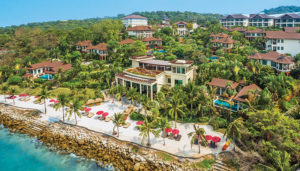PATTAYA, THAILAND—This resort city has long been known for its seedy image, as travelers have flocked here to indulge in various vices, but it’s working hard to reposition itself as a family-friendly destination—and a place where guests can travel in luxury. According to a report by the Tourism Authority of Thailand, the country had 32 million arrivals in 2016; close to eight million of these arrivals visited Pattaya.
Paola Orneli Bock, VP of HVS, who recently published “HVS Market Pulse: Pattaya, Thailand” along with Senior Analyst Pawinee Chaisiriroj, commented on the city’s evolving reputation. “The plans of the local government, especially for areas such as Na Jomtien, as well as the quality and style of new resorts being developed (such as Renaissance, Veranda, Centara Grand and Six Senses) are factors that should contribute to Pattaya’s efforts to reposition itself as a more well-rounded family destination,” she said. “More can be done in terms of attractions outside of resorts, such as cultural venues, recreational and MICE facilities, etc.”
Leanne Harwood, VP/operations, IHG, Southeast Asia and Korea, noted that the area is seeing an increase in visitors seeking luxury travel experiences. “To cater to this growing segment, we introduced our InterContinental Hotels & Resorts brand to Pattaya in 2016,” she said. IHG also offers Holiday Inn Pattaya and is developing Holiday Inn Express Pattaya Central.
“Moreover, the development of the upcoming eastern seaboard industrial hub paves the way for a rise in business visitors to the city seeking smart and convenient accommodation choices. We are well poised to cater to this trend with the upcoming Holiday Inn Express Pattaya Central, ideal for independent travelers seeking a no-fuss and refreshing stay,” said Harwood.
Saurabh Kukreja, GM, Renaissance Pattaya Resort & Spa, which is set to open this fall, said that Pattaya rivals Phuket in terms of tourist offerings, and the convenient location—a 90-minute drive from Suvarnabhumi Airport, the country’s main international hub—makes it a favorite for new and repeat visitors. “Pattaya is already going through a transformation. As accommodation options diversify, it is becoming popular with families and couples seeking a traditional Thai beach holiday,” he said. “The launch of the world’s first Cartoon Network theme park in 2014 added to the draw for families, whilst established attractions like the Nong Nooch Botanical Garden have wide-reaching appeal.”
Certainly, new development is a factor in this changing image. “The new supply coming online over the next few years is predominantly in the upscale segment, with a number of midscale hotels in the pipeline,” said Bock.
But how will supply growth affect the overall economic outlook? “As the market is fairly rate-sensitive, we would expect an increase in inventories to affect both [upscale and midscale]segments. However, the market has shown resilience in the past and depending on the pace of these new openings, a gradual introduction of supply can be absorbed by the market,” said Bock.
Another factor is the renovation of U-Tapao International Airport. A new passenger terminal is expected to open later this year, which will increase its passenger capacity from 800,000 to three million passengers per year, and to five million after 2020, when the second phase is expected to be completed.
“The successful development of a new airport can dramatically change its surrounding area, depending on traffic demand and routes offered,” said Bock. “We would expect U-Tapao airport to be able to attract traffic from provincial China, as well as domestic and regional routes and to alleviate, to a smaller extent, congestions at Bangkok’s airports.”
Harwood agreed with the assessment about the airport—noting traffic would increase sixfold by 2020—and also pointed to plans for a high-speed train route from Bangkok to Pattaya. “In addition to a wide variety of beaches, Pattaya has seen a steady growth in tourist attractions and amenities, including the region’s largest waterpark, a vibrant food and beverage scene and improved travel infrastructure,” she added.
“The private sector needs to work together to ensure Pattaya develops and grows in line with consumer demand,” said Kukreja. “It’s already apparent from the projects coming on board in the Jomtien area that the face of Pattaya is changing and the consensus seems to see this as a positive advancement.
“By 2027, I imagine Jomtien will appear as a destination in its own right, especially due to its close proximity to the U-Tapao airport. The local authorities are also investing in a new highway to Southern Pattaya, as well as other infrastructure developments on the eastern seaboard, which will benefit both business and tourism development,” he added.
And, as is the case for most areas, that Chinese traveler is important. According to HVS’ research, Thailand welcomed 8.8 million Chinese tourists in 2016 (up 10.3%) and, for Pattaya specifically, China accounted for 21% of guests in 2015. Bock and Chaisiriroj noted that, with the number of Chinese tourists to Pattaya growing by 24% per annum between 2011 and 2015, this growth could be attributed to the expansion of budget airline routes between Thailand and China’s primary and secondary cities.
However, many were part of tour groups—the so-called zero-dollar tourists—who contribute very little in tourism dollars, a trend the Thai government has started to crack down on as it pursues quality vs. quantity. HVS noted that the number of Chinese tourists to Thailand fell by 26% in Q4 2016.
“As observed in other markets, we expect the government to maintain its stance on zero-dollar tourists, which may, in the short term, affect the overall influx of Chinese tourist arrivals,” said Bock. “Nonetheless, other markets are showing signs of recovery (Russia). RevPAR for the YTD 2016 was lagging behind that of the same period in 2015 and full-year figures are expected to be on a similar trend. Going forward, there might be further adjustments as new supply enters the market, but we expect a recovery in the medium term.”
Speaking to the desire for high-spend tourists, Harwood noted that IHG has seen “a surge in Chinese travelers especially among a new breed of younger, more independent travelers classified as Chinese free, independent travelers (FITs), comprising smaller groups that eschew the conventional package tours in favor of authentic local experiences.” This segment accounted for nearly 60% of 8.9 million Chinese visitors to Thailand in 2016, according to Thailand’s Ministry of Tourism and Sport. “This trend shapes a positive outlook for the tourism sector because these travelers stay and spend more money, across a wider spectrum of businesses within the hospitality industry,” said Harwood. HB



